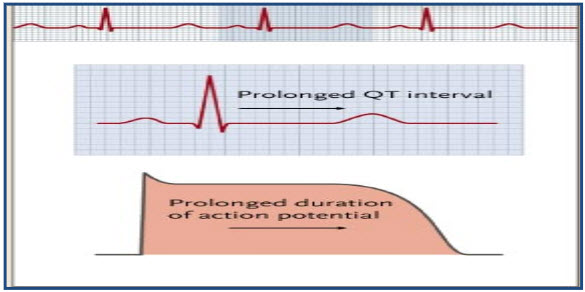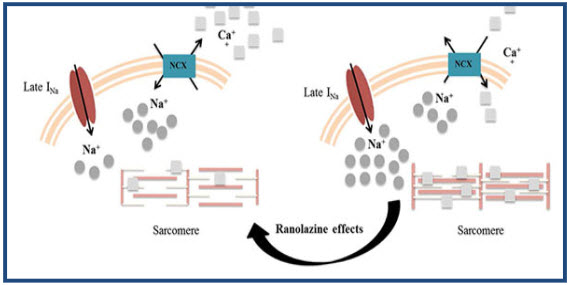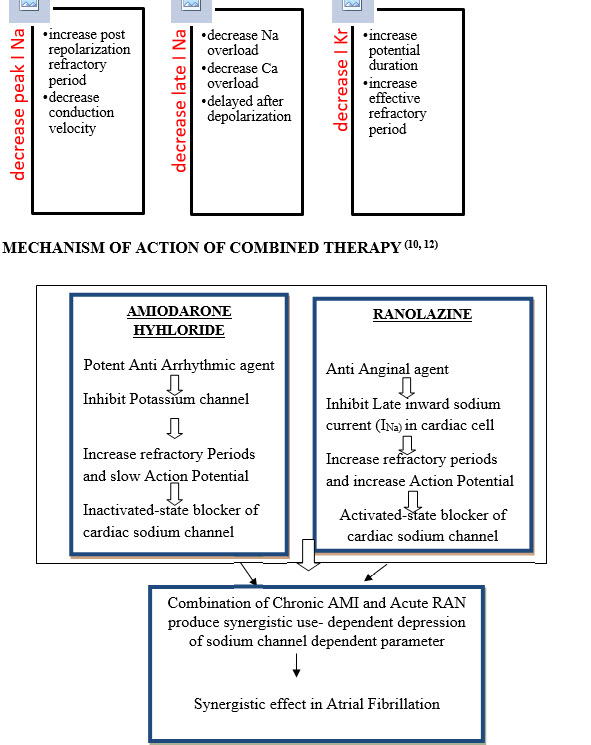{ DOWNLOAD AS PDF }
ABOUT AUTHORS:
Patel Vishakha D*, Raj Hasumati A, Gheewala Nirav K
Department of Quality Assurance,
Shree Dhanvantary Pharmacy College, Kim, Surat
Department of Quality Assurance,
vishuk7293@gmail.com, drharaj@yahoo.com
ABSTRACT:
This review article presents the pharmacology of combined Amiodarone Hydrochloride and Ranolazine therapy specially in Atrial Fibrillation. Amiodarone Hydrochloride is Anti Arrhythmic agent. Ranolazine is a Anti Anginal agent. The Antianginal agent was used in Ischaemia. Amiodarone Hydrochloride is Antiarrhythmic agent and use in Arrhythmia and Atrial fibrillation. If Amiodarone Hydrochloride is administered in large quantities, the condition of patient becomes worse by occurrence of adverse effect of Thyroid toxicity due to presence of Iodine moiety in Amiodarone. The use of Ranolazine in combination with Amiodarone Hydrochloride has been proved to provide beneficial effect in Atrial Fibrillation. The combination therapy has fewer adverse effects. The mechanism of Amiodarone Hydrochloride and Ranolazine is quite different. Amiodarone Hydrochloride inhibit potassium channel and inactivated-state blocker of cardiac sodium channel while Ranolazine inhibit late inward sodium current (INa) in cardiac cell and activated-state blocker of cardiac sodium channel. The combination of both have decrease dose dependent side effect of Amiodarone Hydrochloride. Both the drugs were approved by US government and has been used in Atrial Fibrillation in US.The main objective of this review article is to provide pharmacological information of combined therapy of Amiodarone Hydrochloride and Ranolazine to researcher in development of combined dosage form of this.
INTRODUCTION(1, 2):
An Arrhythmia is an abnormality of rate, rhythm or site of the cardiac impulse or an abnormality in the impulse conduction. Disturbance of impulse generation may be due to altered normal and abnormal automaticity or after-depolarization. In disturbances of impulse conduction, an impulse may recirculate in the heart and cause repeated activation (re-entry).or there should be conduction block.
ATRIAL FIBRILLATION: Atrial fibres are activated asynchronously at a rate of 350-550/min (due to electrophysiological inhomogeneity of atrial fibres), associated with grossly irregular and often fast (100-160/min) ventricular response.
AMIODARONE HYDROCHLORIDE:
MECHANISM OF ACTION:
Amiodarone is categorized as a class III Antiarrhythmic agent and prolongs phase 3 of the cardiac action potential, the repolarization phase where there is normally decreased calcium permeability and increased Potassium permeability.
It inhibits POTASSIUM CHANNELS and VOLTAGEGATED SODIUM CHANNELS. There is a resulting decrease in heart rate and in vascular resistance.(4)

Figure 1: Mechanism action of Amiodarone Hydrochloride(5)
Amiodaroneis highly lipophilic long acting drug.. Amiodarone shows noncompetitive beta blocker-like and potassium channel blocker-like actions on the SA and AV nodes, increases the refractory period via sodium and potassium-channel effects, and slows intra-cardiac conduction of the cardiac action potential, via sodium channel effects.(3)
PHARMACOKINETIC:
|
Parameter |
Observation |
|
Bioavailability |
20-55 % |
|
Metabolism |
Liver |
|
Biological half-life |
58 days(range 15-14 days) |
|
Excretion |
Primarily Hepatic and Billary |
Table 1: Pharmacokinetic Parameter of Amiodarone Hydrochloride
20-55% of an oral dose is absorbed. Metabolize in liver via CYP2C8,1% unchanged in urine. Major metabolite is Desethylamiodarone, negligible excretion of amiodarone and DEA in urine.
RANOLAZINE:
MECHANISM OF ACTION

Figure 2: Mechanism of Ranolazine in Ischaemia(8)
Ranolazine a piperazine derivative is a new anti-ischemic drug for the treatment of angina and atrial fibrillation.The effect of ranolazine to block late INa has the potential to disrupt this cycle by reducing intracellular calcium accumulation and the accompanying decrease in ventricular wall tension. Two beneficial Effect- First, the reduction in wall tension during diastole should reduce the consumption of oxygen and ATP for contractile work, and thus oxygen demand. Secondly, the reduction of wall tension should reduce vascular compression. Because vascular compression causes closure of small vessels and reduction of blood flow, a reduction in compression may lead to increased myocardial nutritive blood flow and oxygen supply to the myocardium during diastole.(7)
As a late INa inhibitor, ranolazine was also shown to increase action potential duration and thus modestly QT interval by 2–5 ms. This effect, however, is not heart rate-dependent and cannot be exaggerated during bradycardia. Furthermore, ranolazine does not induce early after depolarization and does not increase dispersion of repolarization across the left ventricular wall.(6)
Pharmacokinetic:
|
Parameter |
Observation |
|
Bioavailability |
35 to 50 % |
|
Protein binding |
62% |
|
Metabolism |
Hepatic, CYP extensively involved |
|
Biological half-life |
7 hours |
|
Excretion |
Renal-75 % ,Fecal-25 % |
Table 2: Pharmacokinetic Parameter of Ranolazine
After oral administration of ranolazine as a solution, 73%of dose is systemically available., metabolize mainly by CYP3A and to a lesser extent by CYP2D6. excreted unchanged in urine, feces.
COMBINATION THERAPY OF AMIODARONE HYDROCHLORIDE AND RANOLAZINE
The combination provides the remedy for prevention of Atrial Fibrillation with less adeverse effect , safety and having high clinical effects.(9)
Combination of ranolazine with Amiodarone demonstrated efficacy superior to amiodarone alone. Combination treatment is safe and more effective and faster restoration of sinus rhythm.(11)
Amiodarone is toxic drug and its undesirable side effect like thyroid toxicity are dose dependent and so methods of increasing the efficacy of amiodarone to enable a reduction of dose are highly desirable.
Combination of Chronic amiodarone and relatively low concentration of Acute ranolazine produce a synergistic use-dependent depression of sodium channel-dependent parameters lead to a potent effect of drug combination to prevent induction of AF.
Both the drugs were approved by the US Government, and have frequently been used for the treatment of atrial fibrillation in US. This study will test the safety and efficacy of the combination therapy with these agents in patients with atrial fibrillation.(10,12)
Combined Effect in Atrial fibrillation:

MECHANISM OF ACTION OF COMBINED THERAPY(10, 12)
CONCLUSION:
By reviewing the all literatures, the combination therapy was found to be effective in treatment of atrial fibrillation. This review represents individual pharmacology and pharmacokinetic of Amiodarone Hydrochloride and Ranolazine as well as mechanism of action of combination of Amiodarone Hydrochloride and Ranolazine in treatment of atrial fibrillation. This review will helpful for researcher in future studies and also for development of combined formulation of Amiodarone Hydrochloride and Ranolazine as there no formulation is available.
REFERENCES:
1. Barar F.S.K., Essentials of Pharmacolotherapeutics; S.Chand & Company Ltd, New Delhi, 2005, 1th Edn; pp 258.
2. Tripathi K.D., Essentials of Medical Pharmacology; Jaypee Brothers Medical Publishers (P) LTD, New Delhi, 2009, 8th Edn; 508-509.
3. H.P.Rang., M.M.Dale., J.M.Ritter., and R.J.Flower. Rang and dale’s Pharmacology; Elsevier, Mumbai, 2007, 11th Edn; pp 288.
4. Dan M.R., Goodman & Gillman’s The pharmacological basis of Therapeutics; The McGraw-Hill Companies Inc, New Delhi, 2006, 10th Edn; 953-954.
5. SLU Medicine Resident, “Mechanism of Action-Amiodarone”, March 2007, slu.resident.blogspot.in
6. Hasenfuss G and Maier L.S, “Mechanism of action of the new anti-ischemia drug ranolazine.” Clin. Res. Cardiol. 2008, 97(4), 222-226.
7. Luiz B, John C, Shryock and Heather F, “The mechanism of ranolazine action to reduce ischemia-induced diastolic dysfunction.”, Eur Heart J Suppl. 2006, 8(supplement A), A10-A13
8. Carbon F, “Update on evidence for treatment with ranolazine in stable angina”, October 2013, PHARMACOLOGY ARTICLE.docx
9. Konstantinos CK, Nikolaso F, Demosthenes K, Vassileios S et.al., “Ranolazine enhances the efficacy of amiodarone for conversion of recent-onset atrial fibrillation.” Europace.; 2014, 16(7); 973-979.
10. Fragakis N, koskinas K.C, Katritsis D.G, Pagourelias E.D et.al., “Comparision of effectiveness of ranolazine plus amiodarone versus amiodarone alone for conversion of recent-onset atrial fibrillation.” Am J Cardiol. 2012, 110(5), 673-677.
11. Serge S, Alexandr B, Luiz B and Charles A, “Synergistic Electrophysiologic and Antiarrhythmic effects of the Combination of Ranolazine and Chronic Amiodarone in Canine Atria.” Circ Arrhythm Electrophysiol. 2009, 3(1); 88-95.
12. Antzelevich C, Burashnikov A, Shryock S and Belardinelli L. Method treating atrial fibrillation. European Patents EP2337559A2, 2009.
REFERENCE ID: PHARMATUTOR-ART-2404
|
PharmaTutor (Print-ISSN: 2394 - 6679; e-ISSN: 2347 - 7881) Volume 4, Issue 4 Received On: 16/10/2015; Accepted On: 30/11/2015; Published On: 01/04/2016 How to cite this article: Patel VD, Raj H, Gheewala N; Pharmacology of Combined Ranolazine and Amiodarone Hydrohloride therapy to treat Atrial Fibrillation; PharmaTutor; 2016; 4(4); 32-35 |
NOW YOU CAN ALSO PUBLISH YOUR ARTICLE ONLINE.
SUBMIT YOUR ARTICLE/PROJECT AT editor-in-chief@pharmatutor.org
Subscribe to Pharmatutor Alerts by Email
FIND OUT MORE ARTICLES AT OUR DATABASE










